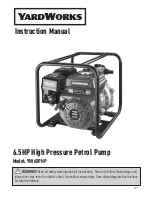
Caution
Caution
RPH
5
2.6
Safety instructions for maintenance,
inspection and installation work
The operator is responsible for ensuring that all maintenance,
inspection and installation work be performed by authorized,
qualified specialist personnel who are thoroughly familiar with
the manual.
The pump must have cooled down to ambient temperature,
pump pressure must have been released and the pump must
have been drained.
Work on the machine / unit must be carried out only during
standstill. The shutdown procedure described in the manual for
taking the unit out of service must be adhered to without fail.
Pumps or pump units handling fluids injurious to health must be
decontaminated.
Immediately
following
completion
of
the
work,
all
safety-relevant and protective devices must be re-installed
and/or re-activated.
Please observe all instructions set out in the chapter on
”Commissioning” before returning the unit to service.
2.7
Unauthorized modification and
manufacture of spare parts
Modifications or alterations of the equipment supplied are only
permitted after consultation with the manufacturer and to the
extent permitted by the manufacturer . Original spare parts and
accessories authorized by the manufacturer ensure safety. The
use of other parts can invalidate any liability of the manufacturer
for consequential damage.
2.8
Unauthorized modes of operation
The warranty relating to the operating reliability and safety of the
unit supplied is only valid if the equipment is used in accordance
with its designated use as described in the following sections.
The limits stated in the data sheet must not be exceeded under
any circumstances.
2.9
Explosion protection
If the pumps/units are installed in potentially explosive
atmospheres, the measures and instructions given in
the following sections 2.9.1 to 2.9.6 must be adhered to without
fail, to ensure explosion protection.
2.9.1
Unit fill
It is assumed that the system of suction and discharge
lines and thus the wetted pump internals are completely
filled with the product to be handled at all times during pump
operation, so that an explosive atmosphere is prevented.
If the operator cannot warrant this condition, appropriate
monitoring devices must be used.
In addition, it is imperative to make sure that the
seal chambers, auxiliary systems of the shaft
seal and the heating and cooling systems are properly filled.
2.9.2
Marking
The marking on the pump only refers to the pump part,
i.e. the coupling and motor must be regarded separately.
The coupling must have an EC manufacturer’s declaration. The
driver must be regarded separately.
Example of marking on the pump part:
Ex II 2 G T1 - T5
The marking indicates the theoretically available temperature
range as stipulated by the respective temperature classes. The
temperatures permitted for the individual pump variants are
outlined in section 2.9.5.
2.9.3
Checking the direction of rotation (see also 6.1.4)
If the explosion hazard also exists during the installation
phase, the direction of rotation must never be checked
by starting up the unfilled pump unit, even for a short period, to
prevent temperature increases resulting from contact between
rotating and stationary components.
2.9.4
Pump operating mode
Make sure that the pump is always started up with the
suction-side shut-off valve fully open and the discharge-side
shut-off valve slightly open. However, the pump can also be
started up against a closed swing check valve. The
discharge-side shut-off valve shall be adjusted to comply with
the duty point immediately following the run-up process (see
6.1.7 ).
Pump operation with the shut-off valves in the suction
and/or discharge pipes closed is not permitted.
In this condition, there is a risk of the pump
casing taking on high surface temperatures
after a very short time, due to a rapid temperature rise in the
pumped fluid inside the pump.
Additionally, the resulting rapid pressure build-up inside the
pump may cause excessive stresses on the pump materials or
even bursting.
The minimum flows indicated in section 6.2.5 refer to water and
water-like liquids. Longer operating periods with these liquids
and at the flow rates indicated will not cause an additional
increase in the temperatures on the pump surface. However, if
the physical properties of the fluids handled are different from
water, it is essential to check if an additional heat build-up may
occur and if the minimum flow rate must therefore be increased.
To check, proceed as described in section 6.2.5.
In addition, the instructions given in section 6 of this operating
manual must be observed.
Both gland packings and mechanical seals may
exceed the specified temperature limits if run dry.
Dry running may not only result from an inadequately filled
seal chamber, but also from excessive gas content in the
fluid handled.
Pump operation outside its specified operating range may
also result in dry running.
In potentially explosive atmospheres, gland packings shall
only be used if combined with a suitable temperature
monitoring device.
2.9.5
Temperature limits
In normal pump operation, the highest temperatures are
to be expected on the surface of the pump casing, at the
shaft seal and in the bearing areas. The surface temperature at
the pump casing corresponds to the temperature of the fluid
handled.
If the pump is heated, it must be ensured that the temperature
classes stipulated for the plant are observed.
In the bearing bracket area, the unit surfaces must be freely ex-
posed to the atmosphere.
In any case, responsibility for compliance with the
specified fluid temperature (operating temperature) lies
with the plant operator. The maximum permissible fluid
temperature depends on the temperature class to be
complied with.
The table below lists the temperature classes to EN 13463-1
and the resulting theoretical temperature limits of the fluid
handled. In stipulating these temperatures, any temperature
rise in the shaft seal area has already been taken into account.
Temperature class
to EN 13463-1:
Temperature limit of fluid handled
T5
T4
T3
T2
T1
85
°
C
120
°
C
185
°
C
280
°
C
max. 400
°
C
*)
*) depending on material variant






































